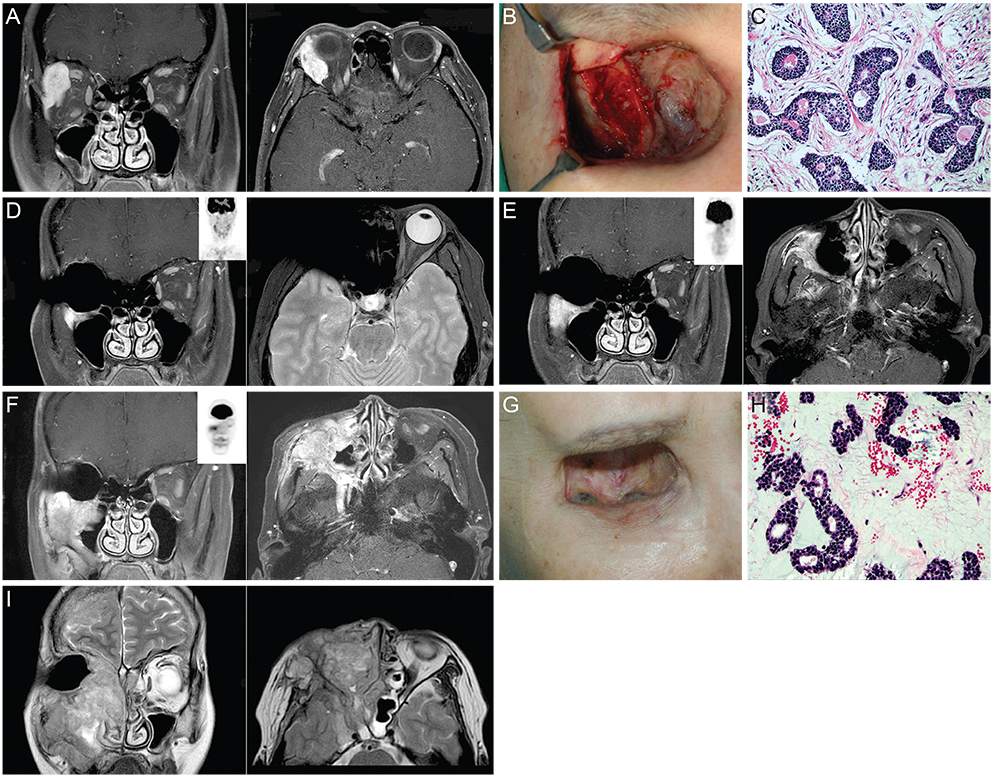Korean J Ophthalmol.
2015 Feb;29(1):68-70. 10.3341/kjo.2015.29.1.68.
Recurred Adenoid Cystic Carcinoma of Lacrimal Gland with Aggressive Local Invasion to the Maxillary Bone Marrow without Increased Uptake in PET-CT
- Affiliations
-
- 1Department of Ophthalmology, Severance Hospital, Institute of Vision Research, Yonsei University College of Medicine, Seoul, Korea. yoonjs@yuhs.ac
- 2Department of Pathology, Yonsei University College of Medicine, Seoul, Korea.
- KMID: 2360141
- DOI: http://doi.org/10.3341/kjo.2015.29.1.68
Abstract
- No abstract available.
MeSH Terms
-
Bone Marrow/*pathology/radiography/radionuclide imaging
Carcinoma, Adenoid Cystic/*diagnosis
Eye Neoplasms/*diagnosis
Female
Humans
Lacrimal Apparatus/*pathology/radiography/radionuclide imaging
Lacrimal Apparatus Diseases/*diagnosis
Maxilla
Middle Aged
Neoplasm Invasiveness
Neoplasm Recurrence, Local
*Positron-Emission Tomography
*Tomography, X-Ray Computed
Figure
Reference
-
1. Esmaeli B, Ahmadi MA, Youssef A, et al. Outcomes in patients with adenoid cystic carcinoma of the lacrimal gland. Ophthal Plast Reconstr Surg. 2004; 20:22–26.2. Tse DT, Kossler AL, Feuer WJ, Benedetto PW. Long-term outcomes of neoadjuvant intra-arterial cytoreductive chemotherapy for lacrimal gland adenoid cystic carcinoma. Ophthalmology. 2013; 120:1313–1323.3. Fellman M, Carter K, Call CB, Esmaeli B. Disease recurrence after intraarterial chemotherapy in 2 patients with adenoid cystic carcinoma of lacrimal gland. Can J Ophthalmol. 2013; 48:e17–e18.4. Lee JY, Choi JY, Ko YH, et al. 18F-FDG PET/CT in patients with initially diagnosed adenoid cystic carcinoma of the head and neck: clinicoplathologic correlation. Nucl Med Mol Imaging. 2009; 43:395–401.5. Qin W, Chong R, Huang X, et al. Adenoid cystic carcinoma of the lacrimal gland: CT and MRI findings. Eur J Ophthalmol. 2012; 22:316–319.
- Full Text Links
- Actions
-
Cited
- CITED
-
- Close
- Share
- Similar articles
-
- Extensive and aggressive growth of adenoid cysticcarcinoma in the lacrimal gland
- A Case of Adenoid Cystic CArcinoma of Unusually Located Lacrimal Gland
- En Bloc Orbitectomy for Recurred Adenoid Cystic Carcinoma of the Lacrimal Gland
- Lacrimal gland adenoid cystic carcinoma: report of an unusual case with literature review
- Skin Metastasis of Adenoid Cystic Carcinoma of Parotid Gland


